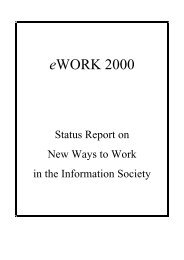Proceedings of 8th European Assembly on telework (Telework2001)
Proceedings of 8th European Assembly on telework (Telework2001)
Proceedings of 8th European Assembly on telework (Telework2001)
Create successful ePaper yourself
Turn your PDF publications into a flip-book with our unique Google optimized e-Paper software.
615.1 MethodologyThe statistical data menti<strong>on</strong>ed in the previous secti<strong>on</strong> were used in such a way that we calculateda ranking <str<strong>on</strong>g>of</str<strong>on</strong>g> countries al<strong>on</strong>g each indicator. For the benefit <str<strong>on</strong>g>of</str<strong>on</strong>g> comparability we have c<strong>on</strong>vertedoriginal indicator values into standardised values with the country showing the highest value beingassigned the benchmark value <str<strong>on</strong>g>of</str<strong>on</strong>g> 100 (see Table 4). Each country was ranked according to itspeformance in each indicator. These ranks were added up and divided by the number <str<strong>on</strong>g>of</str<strong>on</strong>g> indicators,resulting in the AWAI Index values. In this first approach, single indicators were not weighted.The country coverage was restricted to the 10 EC Member States for which data al<strong>on</strong>g all indicatorscould be made available (Denmark, Finland, France, Germany, Ireland, Italy, Netherlands, Spain,Sweden, United Kingdom). For <strong>on</strong>e indicator we had to use estimates to compensate for missingdata in three countries (see footnote 9).This approach, while being very tentative, has the advantage <str<strong>on</strong>g>of</str<strong>on</strong>g> being based <strong>on</strong> rather easilyavailable data. Results can necessarily <strong>on</strong>ly be preliminary, but the AWAI Index seems to be thebest available compound measure <strong>on</strong> the development <str<strong>on</strong>g>of</str<strong>on</strong>g> new ways <str<strong>on</strong>g>of</str<strong>on</strong>g> working yet.5.2 ResultsThe results <str<strong>on</strong>g>of</str<strong>on</strong>g> the above exercise are summarised in the following overview (see Figure 4 and Table4). The higher the AWAI value, the higher the adaptability <str<strong>on</strong>g>of</str<strong>on</strong>g> work arrangements in the respectivenati<strong>on</strong>al labour markets.The group <str<strong>on</strong>g>of</str<strong>on</strong>g> countries with the highest index values, i.e. the highest levels <str<strong>on</strong>g>of</str<strong>on</strong>g> adaptability (theUnited Kingdom, Sweden and Finland) is made up <str<strong>on</strong>g>of</str<strong>on</strong>g> the ‘fast movers’, countries with highlyflexible and dynamic labour markets and labour forces. The sec<strong>on</strong>d group (Denmark and theNetherlands, and also Germany and Ireland) can be described as ‘circumspect followers’, a middlegroup <str<strong>on</strong>g>of</str<strong>on</strong>g> countries which attempt at combining (positive) aspects from the past with adaptati<strong>on</strong> tothe future, while the third group (Italy, France and Spain) may be called the ‘sedentaries’, i.e. theslow movers which are running the danger to miss the c<strong>on</strong>necti<strong>on</strong> to developments in the rest <str<strong>on</strong>g>of</str<strong>on</strong>g> theEU Member States and to be overtaken by other countries, e.g. from Asia, which are developingvery rapidly.








